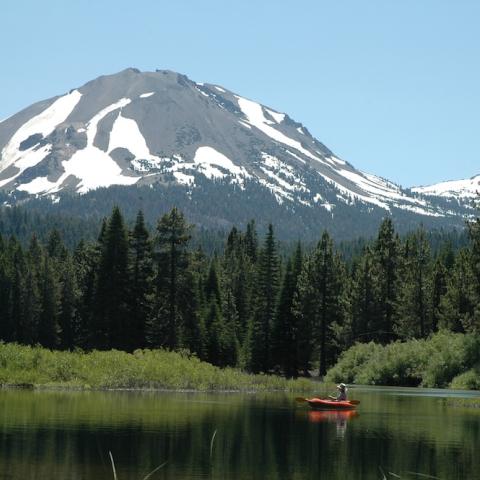
The view from atop Cinder Cone, Lassen Volcanic National Park / Rebecca Latson
A couple of months ago, I traveled to Lassen Volcanic National Park in California. A highlight of my stay was a hike along, and then up, the steep Cinder Cone Trail of pumice ash and loose volcanic rock to the summit. Spectacular bird’s-eye views of the grand volcanic panorama created by the Fantastic Lava Beds and the Painted Dunes rewarded my physical efforts. Reaching the summit also changed my perspective of both volcanic features.
Perspective is a particular way of viewing things, and how you view your photographic subject is a matter of perspective. Perspectives change, depending upon whether you are at ground level, above, or below your subject. When visiting a national park with your camera, you should capture varying perspectives because they not only flesh out the story of your compositional subject, but also of your park trip, as a whole, while building your photographic observational skills.
Back in 2013, I wrote an article for the Traveler regarding scale, perspective, and connection. In that article, I concentrated on lens perspective and how different lenses change your perception of the same subject while standing, more or less, at the same spot. In this article, I want to continue with photographic perspective, but along the lines of how it’s not so much the lens changing that perspective as it is the view of your subject from different locations.
Let’s return to Cinder Cone’s volcanic landscape. The moment you exit your vehicle at the parking lot beside Cinder Cone trailhead, you’ll see the black, blocky piles of lava stretching into Butte Lake, creating a wall one-to-several-stories high. Here, you’re beholding the Fantastic Lava Beds from a ground-level perspective.

Butte Lake and the Fantastic Lava Beds, Lassen Volcanic National Park / Rebecca Latson
Along the same trail, you also first view the Painted Dunes from a ground-level perspective as smooth, undulating hills dotted with sporadic trees. To see those colorful brush strokes of oxidized ash on the dunes, you’ll need to change your perspective and expend a little energy hiking that final 200 feet up to the summit. From that lofty height, you can peer down upon areas of bright orange, gold, and yellow dusting the beige and ash-brown landscape canvas.

Painted Dunes at ground level, Lassen Volcanic National Park / Rebecca Latson
From your perch on the crater rim, notice the interfingering expanse of dark, uneven Fantastic Lava Beds encroaching upon those smooth ash dunes.

Snag Lake, the Fantastic Lava Beds, and Painted Dunes seen from Cinder Cone summit, Lassen Volcanic National Park / Rebecca Latson
The switch in location from ground level to summit changes not only perspectives, but also kicks in those photographic powers of observation. Explore the scenery from the summit long enough and I’ll wager you’ll begin noticing textural differences between lava beds and ash dunes. You’ll also discern interesting shapes and patterns in the colorful dunes and how the shifting daylight affects those shapes and colors.

The colors, patterns, and shapes of Painted Dunes, Lassen Volcanic National Park / Rebecca Latson
Capture all of this with your camera – the perspective change, the texture, light, and color changes - using both wide-angle and telephoto lenses or settings.
Speaking of telephoto lenses, be aware, as you zoom in on those brightly-hued dunes, of a peculiarity you might encounter depending upon the time of day you visit: heat distortion waves shimmering above the ashy landscape. I noticed it from my mid-day perch but didn’t give much thought to it until I returned home to review and edit my files, discovering most of my 100-400mm telephoto shots were rendered useless due to blurring unless I cropped out a great deal of the composition. I originally attributed this outcome to photographer error because I handheld the weighty camera / lens combo while still breathing heavily from the trek up the trail. A quick Google search dispelled that second guessing after pulling up a few articles, including a 2019 blog post by photographer Kevin Lisota, regarding heat distortion and zoom lenses. The next time I trek to Cinder Cone’s top (and I’m considering it for 2023), I’ll time my visit much earlier or later in the day, perhaps catching a sunset and night sky images over the landscape from the crater summit.
Here's an oft-photographed view captured at Kings Creek Meadow Viewpoint, one of 16 Lassen Volcanic National Park Highway highlights identified by numbered markers along the road. That meandering creek over lush grass is a very popular photo subject with a gazillion shots posted of the spot upon which I stood. That didn’t mean I should ignore this scenic vista, and neither should you, if you find your camera aimed toward this, or any other popular park setting. Go ahead and get that photo. It’s your picture taken with your camera, which makes it different from all the other photos snapped at this location. Besides, time of day, weather conditions, and season make your image unique among others.

Lassen Peak above a Kings Creek Meadow vista, Lassen Volcanic National Park / Rebecca Latson
A day later, heading back down from the Bumpass Hell area, I pulled onto a turnout for a higher-elevation view of the meadow below. Although I didn’t photograph the same exact location as the previous day’s shot, it was still Kings Creek Meadow, and I could see below me pencil squiggles of creek meanders across golden grass. From this elevated perspective, the meadow sure looked a lot smaller than when I photographed the area at ground level.

An elevated perspective of Kings Creek Meadow, Lassen Volcanic National Park / Rebecca Latson
Entering Lassen from the park’s southwestern entrance introduces the visitor to sobering views of charred tree skeletons whose leaves and needles were devoured by the 2021 Dixie Fire. Pull over for a moment, get out, and survey the aftermath. Because hidden dangers such as camouflaged snags, ash-and-needle-covered holes, and even the possibility of falling branches or trees lurk beyond the road, stay where you are and use your telephoto lens or telephoto setting to close in on the blackened forest remains. Maybe even use a couple of burnt trees as natural frames.

A ground-level view of the 2021 Dixie Fire aftermath, Lassen Volcanic National Park / Rebecca Latson
Now, keep that ground-level view in mind while climbing the road to the turnout about a half-mile beyond Sulphur Works. Get out of your vehicle again to survey the swath of parallel black trees, a portion of which you photographed earlier from the perspective of a lower elevation. What do you observe, beyond just a burnt forest? Do you notice the parallel trees standing upright like so many pointy toothpicks? Do you see just how close the fire came to engulfing the Kohm Yah-mah-nee Visitor Center and how you can see the ground around each and every tree, versus the thick green coverage of the forest in the background hills?

Charred landscape, Lassen Volcanic National Park / Rebecca Latson
Yes, this entire article is about the same thing: perspective changes due to location and elevation changes (without the use of a drone, which is illegal in a national park, fyi). But these images provide tangible examples of how photographing the same subject from different vantage points enhances your observational skills while encouraging you to flesh out the story of your subject and your park visit. You, and your viewing audience, will ultimately appreciate the extra effort expended and you’ll actually remember more of that particular spot and of your trip, I guarantee it.




 Support Essential Coverage of Essential Places
Support Essential Coverage of Essential Places






